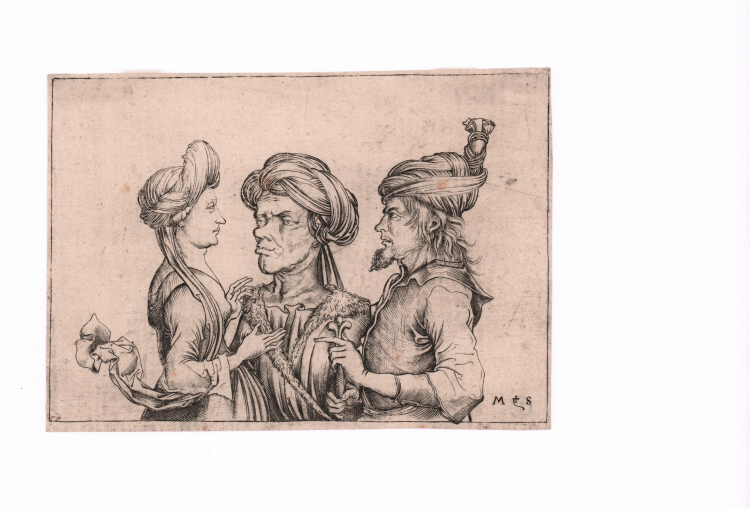



| Reference: | S39928 |
| Author | Martin SCHONGAUER |
| Year: | 1500 |
| Measures: | 162 x 117 mm |


| Reference: | S39928 |
| Author | Martin SCHONGAUER |
| Year: | 1500 |
| Measures: | 162 x 117 mm |
Engraving, 1480-1500 circa, lettered lower right 'M & S'.
It is a contemporary copy probably made by the artist's school.
Very good example, printed on contemporary laid watermarked paper, trimmed close the marginal line, occasional foxing scattered, otherwise in very good condition.
On verso, two collection marks of Pierre Sentuc (Lugt 3608)
Bearded, turbaned oriental figures are so common in Schongauer's work, that it is likely that these figures, which appear to be unrelated to each other, are based on drawings by Schongauer, and maybe inspired by his “Two Moors (or Turks) in Conversation” (TIB, 0801.089; Bartsch, 90; Lehrs, 89).
According to Lehrs, the plate was in the Praun collection, Nuremberg.
Very rare work.
|
Bartsch, VI.174.15; TIB, 8, p. 279 n. 15; Lehrs V, S. 375
|
Martin SCHONGAUER (Colmar 1450 circa - Breisach 1491)
|
The most able engraver and painter of the early German school. Schongauer was known in Italy by the names "Bel Martino" and "Martino d'Anversa".
His father was a goldsmith named Casper, a native of Augsburg, who had settled at Colmar, where the chief part of Martin's life was spent. Schongauer established at Colmar a very important school of engraving, out of which grew the "little masters" of the succeeding generation, and a large group of Nuremberg artists.
As a painter, Schongauer was a pupil of the Flemish Roger van der Weyden the Elder, and his rare existing pictures closely resemble, both in splendour of color and exquisite minuteness of execution, the best works of contemporary art in Flanders.
Among the very few paintings which can with certainty be attributed to him, the chief is a magnificent altar-piece in the church of St Martin at Colmar. The Musée d´Unterlinden in Colmar possesses eleven panels by him, and a small panel of David with Goliath's Head in the Munich Gallery is attributed to him. The miniature painting of the Death of the Virgin in the English National Gallery is probably the work of some pupil. In 1488 Schongauer died at Colmar, according to the register of St Martin's church. Other authorities state that his death occurred in 1491.
The main work of Schongauer's life was the production of a large number of beautiful engravings, which were largely sold, not only in Germany, but also in Italy and even in England. Vasari says that Michelangelo copied one of his engravings--the Trial of St Anthony.
His subjects are always religious; more than 130 prints from copper by his hand are known, and about 100 more are the production of his bottega. Most of his pupils' plates as well as his own are signed M+S. Among the most beautiful of Schongauer's engravings are the series of the Passion and the Death and Coronation of the Virgin, and the series of the Wise and Foolish Virgins. All are remarkable for their miniature-like treatment, their brilliant touch, and their chromatic force. Some, such as the Death of the Virgin and the Adoration of the Magi are richly-filled compositions of many figures, treated with much largeness of style in spite of their minute scale.
|
|
Bartsch, VI.174.15; TIB, 8, p. 279 n. 15; Lehrs V, S. 375
|
Martin SCHONGAUER (Colmar 1450 circa - Breisach 1491)
|
The most able engraver and painter of the early German school. Schongauer was known in Italy by the names "Bel Martino" and "Martino d'Anversa".
His father was a goldsmith named Casper, a native of Augsburg, who had settled at Colmar, where the chief part of Martin's life was spent. Schongauer established at Colmar a very important school of engraving, out of which grew the "little masters" of the succeeding generation, and a large group of Nuremberg artists.
As a painter, Schongauer was a pupil of the Flemish Roger van der Weyden the Elder, and his rare existing pictures closely resemble, both in splendour of color and exquisite minuteness of execution, the best works of contemporary art in Flanders.
Among the very few paintings which can with certainty be attributed to him, the chief is a magnificent altar-piece in the church of St Martin at Colmar. The Musée d´Unterlinden in Colmar possesses eleven panels by him, and a small panel of David with Goliath's Head in the Munich Gallery is attributed to him. The miniature painting of the Death of the Virgin in the English National Gallery is probably the work of some pupil. In 1488 Schongauer died at Colmar, according to the register of St Martin's church. Other authorities state that his death occurred in 1491.
The main work of Schongauer's life was the production of a large number of beautiful engravings, which were largely sold, not only in Germany, but also in Italy and even in England. Vasari says that Michelangelo copied one of his engravings--the Trial of St Anthony.
His subjects are always religious; more than 130 prints from copper by his hand are known, and about 100 more are the production of his bottega. Most of his pupils' plates as well as his own are signed M+S. Among the most beautiful of Schongauer's engravings are the series of the Passion and the Death and Coronation of the Virgin, and the series of the Wise and Foolish Virgins. All are remarkable for their miniature-like treatment, their brilliant touch, and their chromatic force. Some, such as the Death of the Virgin and the Adoration of the Magi are richly-filled compositions of many figures, treated with much largeness of style in spite of their minute scale.
|